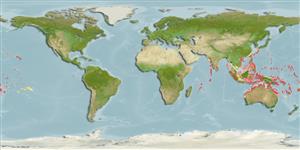>
Eupercaria/misc (Various families in series Eupercaria) >
Scaridae (Parrotfishes) > Scarinae
Etymology: Scarus: Greek, skaros = a fish described by anciente writers as a parrot fish; 1601 (Ref. 45335).
More on author: Valenciennes.
Environment: milieu / climate zone / depth range / distribution range
Ökologie
seewasser riff-verbunden; tiefenbereich 0 - 20 m (Ref. 90102). Tropical; 32°N - 27°S, 57°E - 141°W
Indo-Pacific: Mauritius (Ref. 5503) to the Line and Tuamoto islands, north to the Ryukyu Islands, south to Shark Bay and the Great Barrier Reef.
Size / Gewicht / Alter
Maturity: Lm ? range ? - ? cm
Max length : 44.5 cm TL Männchen/unbestimmt; (Ref. 125599); max. veröff. Gewicht: 2.1 kg (Ref. 125599)
Rückenflossenstacheln (insgesamt): 9; Rückenflossenweichstrahlen (insgesamt): 10; Afterflossenstacheln 3; Afterflossenweichstrahlen: 9. Males recognized by the dark area over head and body, and females yellow barring (Ref. 48636). Closely resembles S. dimidiatus, but S. oviceps differs in that its initial phase has fewer, less vertical diagonal black bars on the back and the terminal phase lacks the light-centered bar between the eye and the pectoral fin base, is darker and less brilliant blue on the upper head and back and is usually larger.
Inhabits lagoon and seaward reefs to at least 10 m (Ref. 9710, 48636). Also found in lagoons and coastal and outer reefs to 20 m deep (Ref. 90102). Feeds on benthic algae (Ref. 89972). Occurs singly (Ref. 4821). May also form groups (Ref. 90102). Minimum depth reported taken from Ref. 128797.
Life cycle and mating behavior
Geschlechtsreife | Fortpflanzung | Ablaichen | Eier | Fecundity | Larven
Oviparous, distinct pairing during breeding (Ref. 205).
Randall, J.E., G.R. Allen and R.C. Steene, 1990. Fishes of the Great Barrier Reef and Coral Sea. University of Hawaii Press, Honolulu, Hawaii. 506 p. (Ref. 2334)
IUCN Rote Liste Status (Ref. 130435)
Bedrohung für Menschen
Harmless
Nutzung durch Menschen
Fischereien: kommerziell; Aquarium: Kommerziell
Mehr Information
ReferenzenAquakulturAquakultur ProfilZuchtlinienGenetikElectrophoresesVererbbarkeitKrankheitenVerarbeitungNutrientsMass conversion
Tools
Zusatzinformationen
Download XML
Internet Quellen
Estimates based on models
Preferred temperature (Ref.
123201): 25 - 29.3, mean 28.4 °C (based on 2163 cells).
Phylogenetic diversity index (Ref.
82804): PD
50 = 0.5000 [Uniqueness, from 0.5 = low to 2.0 = high].
Bayesian length-weight: a=0.01096 (0.00670 - 0.01793), b=3.13 (2.99 - 3.27), in cm total length, based on LWR estimates for this species & Genus-body shape (Ref.
93245).
Trophic level (Ref.
69278): 2.0 ±0.0 se; based on diet studies.
Widerstandsfähigkeit (Ref.
120179): mittel, Verdopplung der Population dauert 1,4 - 4,4 Jahre. (Preliminary K or Fecundity.).
Fishing Vulnerability (Ref.
59153): Low to moderate vulnerability (35 of 100).
Nutrients (Ref.
124155): Calcium = 50.5 [28.0, 86.0] mg/100g; Iron = 0.74 [0.48, 1.26] mg/100g; Protein = 18.1 [16.0, 20.0] %; Omega3 = 0.0551 [, ] g/100g; Selenium = 19.6 [10.2, 36.1] μg/100g; VitaminA = 50.2 [12.6, 193.9] μg/100g; Zinc = 2.41 [1.72, 3.30] mg/100g (wet weight);
